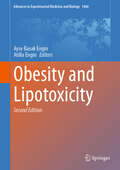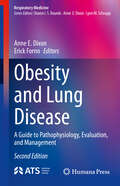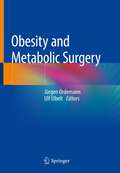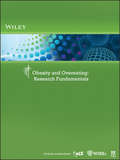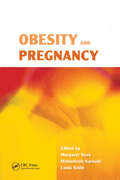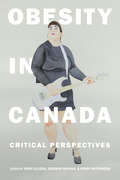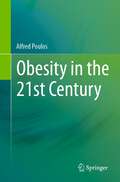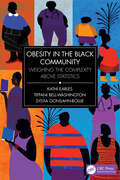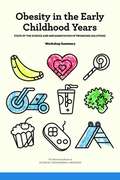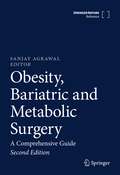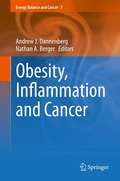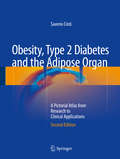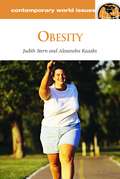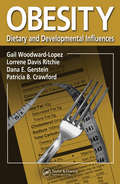- Table View
- List View
Obesity and Fertility
by Emily S. JungheimThis book outlines the current understanding of how obesity affects female reproductive function across the lifespan. Topics include physiology of the menstrual cycle and early pregnancy, best practices in the delivery of contraceptive and prenatal care and healthcare policy that weighs the evidence in appropriate balance with principles that respect women's rights. Special attention is devoted to the idea that obesity's adverse effects are likely trans-generational; that is, children born to obese mothers are at increased risk for obesity, diabetes and cardiovascular disease later in life. Patients and their physicians need to be aware of the additional risks obesity confers in pregnancy and outline a plan of care that includes counseling preconceptionally, antepartum, intrapartum and postpartum in order to decrease morbidity. Obesity and Fertility provides advice for reproductive medicine physicians and gynecologists to help guide obese patients toward improved reproductive health and outcomes.
Obesity and Lipotoxicity
by Atilla Engin Ayse Basak EnginDue to the resultant health consequences and considerable increase in prevalence, obesity has become a major worldwide health problem. "Obesity and Lipotoxicity" is a comprehensive review of the recent researches to provide a better understanding of the lipotoxicity-related mechanisms of obesity and the potential for the development of new treatment strategies. This book overviews the biochemical pathways leading to obesity-related metabolic disorders that occur subsequent to lipotoxicity. Chapters examine the deleterious effects of nutrient excess at molecular level including the cellular and molecular aspects of breast cancer, resistance to leptin, insulin, adiponectin, and interconnection between the circadian clock and metabolic pathways during high-fat feeding. "Lipotoxicity and Obesity" will be a useful resource for clinicians and basic science researchers, such as biochemists, toxicologists, immunologists, nutritionists, adult and pediatric endocrinologists, cardiologists, as well as students who are thought in this field.
Obesity and Lipotoxicity (Advances in Experimental Medicine and Biology #1460)
by Atilla Engin Ayse Basak EnginThis book is a comprehensive review of the recent research on the lipotoxicity-related mechanisms in obesity and the development of new treatment strategies. In this second edition, the possible molecular treatment methods and their recent clinical approaches are discussed in addition to the basic mechanisms that are available and thoroughly reviewed previously. Moreover, all chapters have been reviewed, according to the current concepts and seven new chapters are added, covering obesity-related epigenetic modifications, senescence, obesity-related cancer development, endocrine disruptors, as well as nanotechnology-based clinical approaches. This book is an essential resource for clinicians and basic science researchers, such as biochemists, toxicologists, immunologists, nutritionists, adult and pediatric endocrinologists, and cardiologists, as well as all researchers or students who want to learn the mysteries of obesity.
Obesity and Lung Disease
by Emmanuelle M. Clerisme-Beaty Anne E. DixonAs a result of the rapidly growing rate of obesity worldwide, clinicians are struggling to provide the best strategies for treating obese patients with concomitant pulmonary conditions. Obesity does not simply change the epidemiology of pulmonary disease; obesity has a profound impact on the pathophysiology of common pulmonary diseases. Obesity affects the severity of asthma, response to treatment, and is likely a major modifier of the phenotype of asthma. Obesity also appears to affect response to pathogens, and as such has a major influence on response to pneumonia, and has a significant impact on outcomes pertaining to acute lung injury in the intensive care unit. Obesity and Lung Disease: A Guide to Management is the first text in the field to cover the full range of issues related to managing obese patients with pulmonary problems. All the relevant conditions, in the context of obesity, are covered, including airway inflammation, sleep apnea, asthma, pulmonary hypertension, obesity hypoventilation, as well as others. Written by an international group of experts, this important new volume is an invaluable resource for all clinicians and scientists concerned with the challenging problems surrounding obesity and lung diseases.
Obesity and Lung Disease: A Guide to Pathophysiology, Evaluation, and Management (Respiratory Medicine)
by Anne E. Dixon Erick FornoThis new edition provides a fully updated guide to obesity’s relation to lung disease. Over forty percent of the U.S. population is obese, and obesity is increasing in much of the world. Obesity has a major impact on health conditions such as diabetes and cardiovascular disease. The effects of obesity on lung disease have drawn increasing attention in recent years. Furthermore, the COVID pandemic has dramatically illustrated how obesity affects respiratory disease, constitutes a major risk factor for COVID-19, and presents challenges to pulmonary care in the ICU. Obesity changes physiology, immune and metabolic function, and is associated with changes in diet and the microbiome, all of which combine to have a major impact on the pathogenesis of respiratory diseases. Obesity is thus a risk factor for many respiratory diseases such as asthma, pulmonary hypertension, thromboembolic disease, obstructive sleep apnea and ARDS. Obesity also complicates the management of manyother respiratory diseases and conditions such as COPD, thromboembolic disease, and the care of the critically ill patient.The objectives of this book are three-fold: To review how physiological, immune and metabolic factors might contribute to lung disease. To discuss the impact of obesity on common lung diseasesTo outline important considerations in the management of critically ill obese patients. There have been major advances in our understanding of the relationship between obesity and lung disease since the first edition in 2013, in addition to the major lessons learned about the importance of obesity during the COVID-19 pandemic. This has led to the addition of eight new chapters on topics such as, the microbiome, lung transplant, and COVID-19 in the ICU. This is an ideal guide for all clinicians taking care of patients with pulmonary and critical care diseases, as well as basic and translational scientists interested in how obesity affects respiratory health.
Obesity and Mental Disorders
by George A. Bray David B. Allison Susan L. McElroyCurrently, there are a limited amount of guidelines to help clinicians manage patients with obesity and comorbid mental disorders. This expertly written source fills the gap in the literature by providing a clear overview of obesity and its relationship to mental illness while reviewing the most recent methods to manage and control the condition wi
Obesity and Metabolic Surgery
by Jürgen Ordemann Ulf ElbeltThis book presents the surgical therapy of obesity and metabolic diseases in a practice-oriented and detailed way. The specific surgical procedures with their indications, performance and risks are described precisely in words and pictures. Special emphasis is placed on the choice of the appropriate surgical procedure for the individual patient. In addition to the mechanisms of action, interdisciplinary preoperative evaluation of the patient and postoperative aftercare are explained. Furthermore, surgical, internal and psychosomatic complications and complication management are described. Information on obesity center organization and alternative bariatric therapies complete the volume.This book is a translation of the original German 1st edition Adipositas- und metabolische Chirurgie by Jürgen Ordemann & Ulf Elbelt, published by Springer-Verlag GmbH Germany, part of Springer Nature in 2017. The translation was done with the help of artificial intelligence (machine translation by the service DeepL.com). A subsequent human revision was done primarily in terms of content, so that the book will read stylistically differently from a conventional translation. Springer Nature works continuously to further the development of tools for the production of books and on the related technologies to support the authors.
Obesity and Overeating: Research Fundamentals (Life Science Research Fundamentals)
by WileyWith the increasing worldwide incidence of obesity and the resulting increase in metabolic disorders such as diabetes, cardiovascular diseases and some cancers, an understanding of the multitude of factors that contribute to obesity is crucial for researchers to develop more effective treatments. This collection of overviews and protocols provides the reader with an introduction to the major features of obesity research, including the interplay between energy balance, hormones and neurobiological networks. An overview is provided which describes the animal models of obesity most commonly utilized in research. A standardized laboratory protocol for producing diet?]induced obesity (DIO) in both mouse and rat is provided as are protocols that describe how diet formulation can be modified to generate mouse models of human metabolic pathologies. Protocols are also provided for testing the effects of dietary manipulations, caloric restriction and potential therapeutics. This e-book — a curated collection from eLS, WIREs, and Current Protocols — offers a fantastic introduction to the field of obesity research for students or interdisciplinary collaborators.
Obesity and Pregnancy
by Margaret Rees Louis Keith M A KaroshiUnlike other areas of medicine where statistics are meticulously kept by governments and global organizations, there are no accurate data to describe the number of the world's inhabitants who are overweight, obese, or morbidly obese. Despite this knowledge deficit, it should come as no surprise to readers that the medical community is facing an epidemic. Obesity is present in many of the developed countries and can also be observed in some urban areas of developing nations. The cause of this epidemic, simply stated, is overeating, but the overriding concern is more complex. Social factors, such as growing affluence since the 1950s, increasing reliance on pre-prepared meals, and the popularity of fast foods and sweetened drinks, have all contributed to the problem.Without doubt, the obesity epidemic has had adverse effects on both men and women, but in the case of women, some of its worse complications occur with those who are severely obese and pregnant. Obviously, this combination has been seen in the past, but it has increased so dramatically in its frequency that research has yet to catch up. Studies may discuss one or another aspect of caring for the obese pregnant patient, but until now, there has been no attempt to draw all such material together to try and present a comprehensive appraisal of the problem.Written by international experts, this practical guide draws on evidence-based material and is an invaluable resource for healthcare professionals dealing with obese pregnant women on a day-to-day basis.
Obesity and its Impact on Health
by Methil Kannan Kutty Asita ElengoeThis book summarizes the effects of obesity on health and its correlation with a wide range of debilitating and life-threatening conditions in humans. It discusses the possible pathological mechanisms that are involved in the development of obesity and highlights obesity-associated molecular mechanisms that contribute to reproductive dysfunctions in men and women. The book provides mechanistic insights on the role of obesity in cardiovascular and respiratory disorders, and examines the role of the complementary molecular mechanism of the gut microbiota in the development of obesity. It also reviews the interaction between the metabolic system and immune cells in the pathogenesis of obesity-associated diseases. Lastly, it assesses the latest advances in nanomedicine as an emerging strategy for the treatment of obesity.
Obesity in Canada: Critical Perspectives
by Wendy Mitchinson By Jenny Ellison Deborah McphailMedical professionals, social policy makers, and the media have all declared that Canada is in the grip of an obesity epidemic. Conceptualizing obesity as a biological condition, these experts insist that it needs to be "prevented" and "managed. " Obesity in Canada takes a broader, critical perspective of our supposed epidemic. Examining obesity in its cultural and historical context, the book's contributors ask how we measure health and wellness, where our attitudes to obesity develop from, and what the consequences are of naming and targeting as "obese" those who body weights do not match our expectations. A broad survey of the issues surrounding the obesity panic in Canada, it is the first collection of fat studies and critical obesity studies from a distinctly Canadian perspective.
Obesity in the 21st Century
by Alfred PoulosIn recent years, the focus of obesity prevention has been on diet. However, diet is only one of many factors which play a role in the development of obesity. This book looks at these factors and the latest research on how they contribute to the development of obesity, and the many different methods that have been and are being used to treat and prevent obesity. Written in an accessible language, this book provides the latest and most up to date information on research into the causes, health consequences and treatment of obesity. It educates and advocates for healthier lifestyles, a better understanding of diets and weight loss programs, and associated chronic diseases. It is written for everyone interested in obesity and enables the reader to take informed action to reduce the likelihood of putting on weight and the risk of developing chronic illnesses.
Obesity in the Black Community: Weighing the Complexity above Statistics
by Kathi Earles Tiffani Bell-Washington Sylvia Gonsahn-BollieThis landmark textbook, written by three leading experts in obesity medicine, provides a comprehensive examination of the complexities, challenges, and opportunities in addressing obesity within Black communities. By exploring the interplay of biopsychosocial factors and cultural dynamics, this authoritative resource presents a forward-thinking, evidence-led approach to one of the most critical public health issues of our time.Grounded in the latest research and enriched by clinical expertise, the book offers actionable strategies for healthcare professionals seeking to deliver culturally sensitive and effective care. With a focus on addressing health disparities and dismantling harmful stereotypes, this text sets a new benchmark for equitable and impactful obesity treatment.Key Features Challenges misconceptions and biases to offer practical, solutions-driven approaches to obesity care Combines clinical best practices with cultural competence to enhance patient engagement and outcomes Features contributions from Black physicians, providing valuable insights that blend lived experience with professional expertise Ideal for medical students, clinicians, and healthcare professionals, this essential guide is also a vital resource for researchers and public health advocates dedicated to advancing health equity and improving outcomes for historically underserved populations.
Obesity in the Dog and Cat
by Martha G. Cline Maryanne MurphyThis is an indispensable guide for any veterinarian or veterinary technician interested in better understanding the disease of obesity. The authors reach far beyond the traditional clinical approach of, "Feed less, exercise more," and explore the current pathophysiology of obesity and emerging treatment options. Thoroughly researched and packed with practical advice, this is the textbook I wish I had twenty-five years ago. Highly recommended. - Ernie Ward, DVM, CVFT, Founder, The Association for Pet Obesity Prevention This book will be valuable for anyone managing obesity cases in practice as there is considerable practical information. I found the chapter on behavioral management of obesity especially useful. There is also good information on the pathophysiology and sequaela of obesity. By necessity, there is information from human obesity where we don't have sufficient information in dogs and cats; however, this points to useful areas for future research. - Marge Chandler, DVM, MS, MANZCVS, DACVN, DACVIM-CA, MRCVS, Clinical Nutritionist at Vets Now Referrals, Co-Chair of the WSAVA Global Nutrition Committee, and Chair of the FEDIAF Scientific Advisory Board Key features: Reviews epidemiology and how animal- and human-specific factors contribute to excess weight gain. Discusses the metabolic effects and inflammatory mediators associated with adiposity. Looks at various disease states and how they relate or develop as a result of obesity. Reviews different modalities to determine body composition to diagnose obesity. Offers a clinical approach to managing obesity with diet including discussion on the nutrients of concern for therapeutic weight loss diets. As of 2018, pet obesity in the US affects an estimated 55.8 percent of dogs and 59.5 percent of cats, resulting in secondary conditions such as arthritis, diabetes mellitus, kidney disease, and certain forms of cancer. A complete and balanced diet accompanied by regular exercise is fundamental to optimize health and longevity in companion animals, meaning overweight pets have reduced quality of life and shorter life expectancy. Seeking to address this major modern-day problem, this book provides a comprehensive review of obesity in small animal medicine. Veterinarians seeking to provide weight management services in practice will find clinically-applicable information from expert authors from both academic and practice backgrounds. Chapters cover topics ranging from epidemiology and pathophysiology of obesity to evaluation of body composition, and nutritional and behavioral management. The book also explores the role of exercise in managing obesity and looks at the management of co-morbidities. Finally, the authors present a range of case studies to demonstrate these topics in real-life practice.
Obesity in the Early Childhood Years: Workshop Summary
by Engineering Medicine National Academies of SciencesAmong the many troubling aspects of the rising prevalence of obesity in the United States and elsewhere in recent years, the growth of early childhood overweight and obesity stands out. To explore what is known about effective and innovative interventions to counter obesity in young children, the National Academies of Sciences, Engineering, and Medicine’s Roundtable on Obesity Solutions held a workshop in October 2015. The workshop brought together many of the leading researchers on obesity in young children to describe the state of the science and potential solutions based on that research. Participants explored sustainable collaborations and new insights into the implementation of interventions and policies, particularly those related to nutrition and physical activity, for the treatment and prevention of obesity in young children. Obesity in the Early Childhood Years summarizes the presentations and discussions from the workshop.
Obesity, Bariatric and Metabolic Surgery
by Sanjay AgrawalWritten by leading experts from all across the globe, this comprehensive yet concise textbook offers up-to-date summary in the field of Obesity and its Surgical Management for a wide range of healthcare professionals involved within a Bariatric Multidisciplinary Team including Surgeons, Dieticians, Metabolic Physicians, Anaesthesiologists, Psychologists, Psychiatrists, Radiologists and Nursing staff. The book also serves as a reference manual for General Physicians, General Surgeons & General Practitioners.
Obesity, Bariatric and Metabolic Surgery: A Practical Guide
by Sanjay Agrawal<p>This comprehensive guide with over 100 chapters covers all the aspects of bariatric and metabolic surgery including perioperative management, surgical techniques of common as well as newer procedures, complications, controversies and outcomes. All the chapters have been revised in this second edition with addition of new chapters and sections on OAGB/MGB Surgery & Metabolic Surgery. There are dedicated sections on revisional surgery and innovative endoscopic procedures. The book is well illustrated with photos and video clips along with step-by-step guidance for a complete range of Bariatric procedures. Medical aspects of obesity and metabolic syndrome are included in the introductory sections, and the last two sections cover diverse topics in this exciting field of bariatric surgery.<p> <p>Written by leading experts, Obesity, Bariatric and Metabolic Surgery - A Comprehensive Guide serves as an excellent reference manual for a wide range of healthcare professionals involved within the Bariatric Multidisciplinary Team including Bariatric Surgeons, General Surgeons, Trainees, Physicians, Anaesthesiologists, Dieticians, Psychologists, Psychiatrists, Radiologists and Nursing staff.<p>
Obesity, Diabetes and Inflammation: Molecular Mechanisms and Clinical Management (Contemporary Endocrinology)
by Leonid Poretsky Dimiter AvtanskiObesity is a worldwide epidemic that affects half a billion people. It has been estimated that, if current trends continue, by 2050, 60% of men and 50% of women worldwide will be obese. Hypertrophy and hyperplasia of white adipose tissue caused by overweight and obesity lead to a chronic inflammatory state, which results in impaired insulin sensitivity and the development of diabetes. Currently, the number of people affected by diabetes globally exceeds 400 million (rising more rapidly in low- and middle-income countries). In 2019, diabetes was the ninth leading cause of mortality, with an estimated 1.5 million direct deaths. This book provides a comprehensive overview of the relationship between inflammation, obesity, and diabetes. It focuses on the pathogenesis and biological mechanisms of obesity, the interaction between adipose tissue and the immune system, the role of genetic and environmental factors, the progression of cardiovascular complications, and the association of obesity and inflammation with type 1 and type 2 diabetes, as well as gestational diabetes. This volume also includes practical recommendations for preventing and managing these conditions using both lifestyle modifications and pharmacological interventions. Written by experts in the field, Obesity, Diabetes and Inflammation: Molecular Mechanisms and Clinical Management addresses the role of inflammation in both obesity and diabetes, its effect on vascular and non-vascular pathologies, oxidative stress, genetics, and epigenetics. This text aims to be a valuable resource for researchers, clinicians, and students of medicine at all levels.
Obesity, Fatty Liver and Liver Cancer (Advances in Experimental Medicine and Biology #1061)
by Jun YuThis volume covers a state-of-the-art illustration of recent discoveries concerning obesity-related fatty liver diseases and liver cancer. The contents are extensive and comprehensive. It brings important topics in the field all together under one umbrella, from epidemiology and etiology, molecular pathogenesis, cellular biology, epigenetics, immunology, microbiology, animal models to therapeutic approaches and treatments. All the book contributors are leading experts in the field. It will appeal to researchers, clinicians and graduate students in obesity, fatty liver diseases, GI/Liver cancer field. It may also yield benefits for pharmaceutical companies with regard to drug discovery.
Obesity, Inflammation and Cancer
by Nathan A. Berger Andrew J. DannenbergIn addition to its metabolic and endocrinologic effects, obesity and adipose tissue have now been shown to be associated with low grade inflammation resulting in cellular and humoral inflammatory factors of which the latter may act by endocrine, paracrine and autocrine mechanisms. These inflammatory mediators have increasingly been suggested as contributing to the obesity link to carcinogenesis and cancer promotion. This volume of Energy Balance and Cancer will focus on recent developments and cutting edge research pointing to inflammation and inflammatory factors as key mediators of this linkage. The volume first provides information on inflammation as an important link between obesity and insulin resistance, which is in itself linked to promotion of cancer through hyperinsulinemia. The volume then covers some of the most important mechanisms by which obesity leads to inflammation, including the novel inflammasome concept, alterations in chromatin structure, circulating inflammatory factors, unique cellular interactions between adipocytes and macrophages and the direct link of dietary fat to inflammation and cancer. Overall, this volume will provide important insight to help understand how inflammation may help modulate the linkage between obesity and cancer and serve as a platform for developing future research in this area.
Obesity, Type 2 Diabetes and the Adipose Organ: A Pictorial Atlas From Research To Clinical Applications
by Saverio CintiThis richly illustrated book provides a detailed description of the gross anatomy, light microscopy, immunohistochemistry, and electron microscopy of the adipose organ, which comprises subcutaneous and visceral fat depots. Findings in mice of differing genetic backgrounds (obesity prone and resistant) and maintained in standard and various physiologic and pathologic conditions are presented. The latter conditions include chronic cold exposure, warm exposure, fasting, pregnancy–lactation, and obesity. Features of the fetal adipose organ are described in a separate chapter, and results from transgenic mice are also presented when relevant. The human adipose organ is addressed in several chapters that include magnetic resonance and fetal findings. Most of the results regarding the adipose organ anatomy in different physiologic conditions are new, and the story of pink adipocytes (white-to-pink transdifferentiation) is quite innovative. The concept of using browning of the adipose organ as a therapeutic tool for obesity must take into consideration the anatomic and morphologic aspects described here, and the study of pink adipocytes could lead to a better comprehension of breast cancer tumor biology. This book will be of interest to all scientists who deal with obesity and related disorders.
Obesity: A Kinesiology Perspective (Routledge Research in Physical Activity and Health)
by Roy J. ShephardThere have been many books written on the subject of obesity, but most have approached the topic from the standpoint of the nutritionist, concluding from the somewhat fallacious evidence of changes in body mass that exercise has little place in the prevention or the treatment of obesity. This new volume, written by an exercise physiologist, approaches the topic through a thoughtful lens, suggesting that regular physical activity plays an important role in preventing the development of obesity, is a valuable adjunct therapy in the treatment of the established condition, and makes a solid contribution to the maintenance of weight loss once target weights have been achieved. In addition to detailing evidence that supports such a conclusion, the text offers a unique perspective on obesity over the ages. It evaluates methods of determining body fat content that are appropriate to field and epidemiological studies, and it looks at the timing and aetiology of the recent obesity epidemic. It also considers the diseases associated with obesity and the resultant medical costs, attempting to disentangle the respective contributions of a sedentary lifestyle and the resultant accumulation of fat to the observed patterns of ill-health. Other sections of the text suggest that adipose tissue has important functions beyond the passive storage of energy, and looks critically at the excuse of "bad genes" that some people plead to explain their excessive body weight. Obesity: A Kinesiologist’s Perspective should thus provide helpful information and be a key resource for students and researchers alike in bariatrics, kinesiology and nutrition as well as the related disciplines.
Obesity: A Reference Handbook
by Judith S. Stern Alexandra KazaksIn this reference, Stern and Kazaks, nutrition researchers at the U. of California, Davis, present information on the topic of obesity, including why people gain weight, why they succeed or fail in losing it, and who they believe is responsible. They cover its history, treatments, the controversy over whether it is a disease, healthy weight management, medications, herbs and supplements, surgery, the influence of food advertising, childhood obesity, and recent increases in obesity, and provide short biographies of key individuals, excerpts from documents, and an annotated list of resources and organizations.
Obesity: Clinical, Surgical and Practical Guide
by Shamim I. AhmadThis heavily revised second edition comprehensively examines the causes and effects of obesity, both on the human body as well as society as a whole. The significance obesity plays in the development of a variety of lethal and non-lethal diseases is discussed, and the prevention and treatment of obesity are looked at in detail. Treatment strategies such as bariatric surgical techniques and descriptions of how to apply the latest assessment technologies are provided for obese adult and pediatric patients. A new section to this edition covers the impact of COVID-19 on obese patients and how it can create extra complications. Obesity: Clinical, Surgical and Practical Guide describes how to best treat and manage individuals with obesity utilizing the latest methodologies. Furthermore, it brings together a large number of international specialists in their field, making it a valuable resource for gastroenterologists, surgeons, researchers, dieticians, physicians, and healthcare providers.
Obesity: Dietary and Developmental Influences
by Gail Woodward-Lopez Lorrene Davis Ritchie Dana E. Gerstein Patricia B. CrawfordFocusing on prevention rather than treatment, Obesity: Dietary and Developmental Influences reviews and evaluates the determinants of obesity. The book uses evidence-based research as a basis to define foods and dietary behaviors that should be supported and encouraged as well as those that should be discouraged. This comprehensive review re


